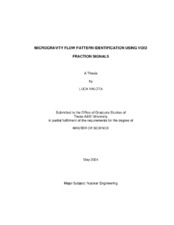| dc.description.abstract | Knowledge of the two-phase flow state is fundamental for two-phase flow system design and operation. In traditional two-phase flow studies, the flow regime refers to the physical location of the gas and liquid in a conduit. Flow configuration is important for engineering correlations of heat and mass transfer, pressure drop, and wall shear. However, it is somewhat subjective since it is mostly defined by experimental observation, resulting in an approximate and equivocal definition. Thus, there is need for a better, objective flow regime identification. The void fraction is a key parameter in monitoring the operating state of a two-phase system and several tools have been developed in order to measure it. The purpose of this study is to use the void fraction and other parameters of the system to achieve a model for flow pattern identification. Recently, an experimental program using the Foster-Miller two-phase flow test bed and Creare Inc. capacitance void fraction sensors was conducted in the microgravity environment of the NASA KC-135 aircraft. Several data types were taken for each phase, such as flow rate, superficial velocity, density and transient void fraction at 100Hz. Several analytical approaches were pursued, including a statistical approach of the fluctuation of the void fraction, Martinelli analysis, and Drift Flux analysis, in order to reach a model for flow pattern identification in microgravity conditions. Several parameters were found to be good flow pattern identifiers such as the statistical moments variance and skewness, Signal -to- noise ratio (SNR), Half Height Value (HHV) and Linear Area Difference (LAD). Moreover, relevant conclusions were achieved using the Martinelli parameter and the Drift Flux model in microgravity conditions. These results were compared with the basic literature. | en |


